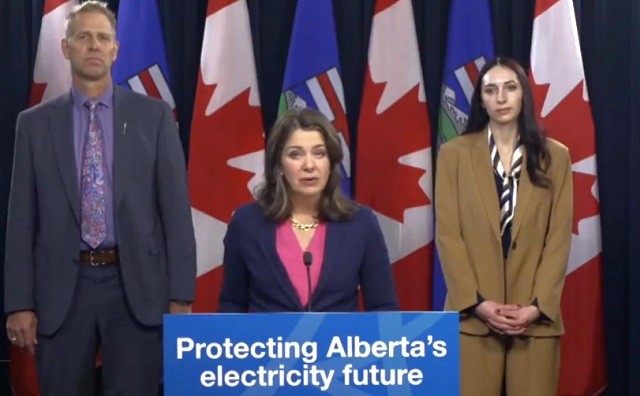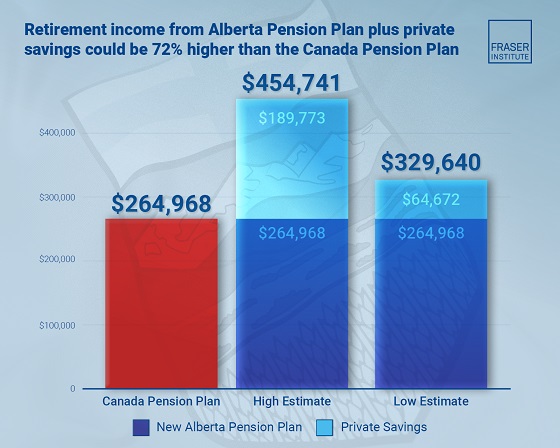Alberta
Danielle Smith vows to protect Albertan farmland from Trudeau’s radical ‘net zero’ push

From LifeSiteNews
‘You cannot build wind turbines the size of the Calgary tower in front of a UNESCO World Heritage Site, or on Nose Hill or in your neighbor’s backyard,’ the province’s premier declared.
Alberta Premier Danielle Smith said her province will continue to rely on reliable carbon-based fuel sources for power generation for decades to come after introducing sweeping new regulations restricting the development of so-called “renewable” energy generation from wind turbines and solar farms, saying these types of technologies are not the “silver bullet” the federal government claims they are for power generation.
“You cannot build wind turbines the size of the Calgary tower in front of a UNESCO World Heritage Site, or on Nose Hill or in your neighbor’s backyard,” Smith said to media on February 28 after announcing the new regulations on so-called “green” power generation.
“We have a duty to protect the natural beauty and communities of our province.”
Breaking…
Alberta Premier Danielle Smith: “You cannot build wind turbines the size of the Calgary Tower in front of a UNESCO world heritage site, or on Nose Hill, or in your neighbour’s back yard.”
Alberta announces new rules for renewable energy projects:
“Renewables have a… pic.twitter.com/a7RN8ZbvAs
— Paul Mitchell (@PaulMitchell_AB) February 28, 2024
Smith’s United Conservative Party government’s new “Renewed path forward for renewable energy” flies in the face of what mostly left-leaning proponents of “green power” claim is needed to rid the world of using “fossil fuels.”
Indeed, the federal government of Prime Minister Justin Trudeau is trying to force net-zero regulations on all Canadian provinces, notably on electricity generation, as early as 2035. Alberta is adamantly opposed to this.
Natural gas and coal are abundant in Canada, notably in Alberta. In the new year, an extreme cold snap sent temperatures plummeting to nearly minus-50 degrees Celsius (58 degrees Fahrenheit) in much of western Canada. It was so cold that the province of Alberta’s power grid almost collapsed due to a failure of wind and solar power.
The UCP had put in place a pause on final approvals for large renewable energy projects, which was lifted on February 29. The UCP’s new guidelines stipulate that new wind or solar projects can only be allowed on Class 1 and Class 2 irrigable lands “unless the proponent can demonstrate the ability for both crops and/or livestock to coexist with the renewable generation project.”
Also, new buffer zones of a “minimum of 35 kilometres” will be established around “protected areas” and other “pristine viewscapes” that the province designates.
All new wind projects will no longer be “permitted within those buffer zones,” and other proposed developments “located within the buffer zone may be subject to a visual impact assessment before approval.”
Alberta’s new rules of solar and wind power generation drew the ire of Trudeau’s Environment Minister Steven Guilbeault, who wrote on X (formerly Twitter) last week that “Renewable energy companies expect to be treated fairly.”
“By placing overkill conditions on new renewable energy, it has the same effect as a moratorium by burying projects in red tape,” he wrote.
The Alberta government notes, despite what some in the federal government might claim, that it is home to about 90% of the renewable power projects in Canada, besides those from nuclear or hydro.
Alberta’s rules stipulate that any renewables that come online must be backed by “baseload” or natural gas/coal power generation, as wind and solar obviously are not reliable when it is dark or there is no wind.
“They are not the silver bullet for Alberta’s electricity needs and they are not the silver bullet of electricity affordability because each new development risks driving up the transmission costs and makes Alberta’s utility bills even more expensive,” Smith said.
In January, LifeSiteNews reported that Canadian Deputy Prime Minister and Finance Minister Chrystia Freeland, while speaking at the World Economic Forum’s (WEF) 2024 meeting in Davos, Switzerland, said it is up to the government to “make” sure the “decarbonization” of Canada’s energy sector “happens.”
Her comments came just after Alberta’s power grid was saved from near collapse due to a cold snap that saw carbon-based energy saved the day after “renewables” failed.
The reduction and eventual elimination of the use of so-called “fossil fuels” and a transition to unreliable “green” energy has been pushed by the WEF – the globalist group behind the socialist “Great Reset” agenda – an organization in which Trudeau and some of his cabinet are involved.
Canada has the third largest oil and gas reserves in the world, with most of it in Alberta. However, since taking office in 2015, Trudeau has continued to push his radical environmental agenda similar to the agendas being pushed the WEF’s “Great Reset” and the United Nations’ “Sustainable Development Goals.”
Alberta
Median workers in Alberta could receive 72% more under Alberta Pension Plan compared to Canada Pension Plan

From the Fraser Institute
By Tegan Hill and Joel Emes
Moving from the CPP to a provincial pension plan would generate savings for Albertans in the form of lower contribution rates (which could be used to increase private retirement savings while receiving the same pension benefits as the CPP under the new provincial pension), finds a new study published today by the Fraser Institute, an independent, non-partisan Canadian public policy think-tank.
“Due to Alberta’s comparatively high rates of employment, higher average incomes, and younger population, Albertans would pay a lower contribution rate through a separate provincial pension plan while receiving the same benefits as under the CPP,” said Tegan Hill, director of Alberta policy at the Fraser Institute and co-author of Illustrating the Potential of an Alberta Pension Plan.
Assuming Albertans invested the savings from moving to a provincial pension plan into a private retirement account, and assuming a contribution rate of 5.85 per cent, workers earning the median income in Alberta ($53,061 in 2025) could accrue a stream of retirement payments totalling $454,741 (pre-tax)—a 71.6 per cent increase from their stream of CPP payments ($264,968).
Put differently, under the CPP, a median worker receives a total of $264,968 in retirement income over their life. If an Alberta worker saved the difference between what they pay now into the CPP and what they would pay into a new provincial plan, the income they would receive in retirement increases. If the contribution rate for the new provincial plan was 5.85 per cent—the lower of the available estimates—the increase in retirement income would total $189,773 (or an increase of 71.6 per cent).
If the contribution rate for a new Alberta pension plan was 8.21 per cent—the higher of the available estimates—a median Alberta worker would still receive an additional $64,672 in retirement income over their life, a marked increase of 24.4 per cent compared to the CPP alone.
Put differently, assuming a contribution rate of 8.21 per cent, Albertan workers earning the median income could accrue a stream of retirement payments totaling $329,640 (pre-tax) under a provincial pension plan—a 24.4 per cent increase from their stream of CPP payments.
“While the full costs and benefits of a provincial pension plan must be considered, its clear that Albertans could benefit from higher retirement payments under a provincial pension plan, compared to the CPP,” Hill said.
Illustrating the Potential of an Alberta Pension Plan
- Due to Alberta’s comparatively high rates of employment, higher average incomes, and younger population, Albertans would pay a lower contribution rate with a separate provincial pension plan, compared with the CPP, while receiving the same benefits as under the CPP.
- Put differently, moving from the CPP to a provincial pension plan would generate savings for Albertans, which could be used to increase private retirement income. This essay assesses the potential savings for Albertans of moving to a provincial pension plan. It also estimates an Albertan’s potential increase in total retirement income, if those savings were invested in a private account.
- Depending on the contribution rate used for an Alberta pension plan (APP), ranging from 5.85 to 8.2 percent, an individual earning the CPP’s yearly maximum pensionable earnings ($71,300 in 2025), would accrue a stream of retirement payments under the total APP (APP plus private retirement savings), yielding a total retirement income of between $429,524 and $584,235. This would be 22.9 to 67.1 percent higher, respectively, than their stream of CPP payments ($349,545).
- An individual earning the median income in Alberta ($53,061 in 2025), would accrue a stream of retirement payments under the total APP (APP plus private retirement savings), yielding a total retirement income of between $329,640 and $454,741, which is between 24.4 percent to 71.6 percent higher, respectively, than their stream of CPP payments ($264,968).

Joel Emes
Alberta
Alberta ban on men in women’s sports doesn’t apply to athletes from other provinces

From LifeSiteNews
Alberta’s Fairness and Safety in Sport Act bans transgender males from women’s sports within the province but cannot regulate out-of-province transgender athletes.
Alberta’s ban on gender-confused males competing in women’s sports will not apply to out-of-province athletes.
In an interview posted July 12 by the Canadian Press, Alberta Tourism and Sport Minister Andrew Boitchenko revealed that Alberta does not have the jurisdiction to regulate out-of-province, gender-confused males from competing against female athletes.
“We don’t have authority to regulate athletes from different jurisdictions,” he said in an interview.
Ministry spokeswoman Vanessa Gomez further explained that while Alberta passed legislation to protect women within their province, outside sporting organizations are bound by federal or international guidelines.
As a result, Albertan female athletes will be spared from competing against men during provincial competition but must face male competitors during inter-provincial events.
In December, Alberta passed the Fairness and Safety in Sport Act to prevent biological men who claim to be women from competing in women’s sports. The legislation will take effect on September 1 and will apply to all school boards, universities, as well as provincial sports organizations.
The move comes after studies have repeatedly revealed what almost everyone already knew was true, namely, that males have a considerable advantage over women in athletics.
Indeed, a recent study published in Sports Medicine found that a year of “transgender” hormone drugs results in “very modest changes” in the inherent strength advantages of men.
Additionally, male athletes competing in women’s sports are known to be violent, especially toward female athletes who oppose their dominance in women’s sports.
Last August, Albertan male powerlifter “Anne” Andres was suspended for six months after a slew of death threats and harassments against his female competitors.
In February, Andres ranted about why men should be able to compete in women’s competitions, calling for “the Ontario lifter” who opposes this, apparently referring to powerlifter April Hutchinson, to “die painfully.”
Interestingly, while Andres was suspended for six months for issuing death threats, Hutchinson was suspended for two years after publicly condemning him for stealing victories from women and then mocking his female competitors on social media. Her suspension was later reduced to a year.
-

 Addictions1 day ago
Addictions1 day agoWhy B.C.’s new witnessed dosing guidelines are built to fail
-

 Frontier Centre for Public Policy2 days ago
Frontier Centre for Public Policy2 days agoCanada’s New Border Bill Spies On You, Not The Bad Guys
-

 Business1 day ago
Business1 day agoCarney Liberals quietly award Pfizer, Moderna nearly $400 million for new COVID shot contracts
-

 Energy2 days ago
Energy2 days agoCNN’s Shock Climate Polling Data Reinforces Trump’s Energy Agenda
-

 Business1 day ago
Business1 day agoMark Carney’s Fiscal Fantasy Will Bankrupt Canada
-

 Opinion1 day ago
Opinion1 day agoPreston Manning: Three Wise Men from the East, Again
-

 Opinion1 day ago
Opinion1 day agoCharity Campaigns vs. Charity Donations
-

 COVID-191 day ago
COVID-191 day agoTrump DOJ dismisses charges against doctor who issued fake COVID passports






